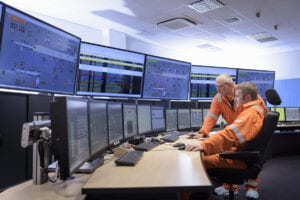According to a recent ARC survey, 93% of industrial stakeholders agree that both edge and cloud processing will form the basis of their industrial automation infrastructure. Market observers and analyst firms are projecting that the cloud computing market will reach $411 billion by 2020 and are forecasting that 50% of data will be processed at “the edge” by 2022.
These major trends will require industrial stakeholders to revisit how they are modernizing their operations in order to drive the new IT-influenced productivity benefits. A first step in achieving these greater productivity gains is to understand how concepts such as “cloud” and “edge” work within an industrial context.
In the IT view, “edge computing” implies data processing that occurs on-premise (i.e., processing not occurring in the cloud, typically occurring in local data centers). Another popular term, “industrial edge,” implies computing that is close to sensors and actuators in the manufacturing area, as close as possible to the production assets (typically occurring in industrial PCs and controllers). When both of these are applied together, they form the basis of the ongoing information technology (IT) and operations technology (OT) convergence in the industrial space.
Understanding edge and cloud drivers
There are multiple reasons for why edge applications are growing in influence across industries. First, because of the sheer volume of data being generated by the new wave of connected devices, it is too costly to send all that data up to the cloud. Edge computing can offer a less expensive alternative. Second, within certain applications, use of the cloud can disrupt performance because of latency issues (an interval of time or waiting period that is too long for data coming back from the cloud to be useful). For example, a blockage in a particular pump needs to be addressed as quickly as possible in order to avoid delays or disruption to production. The pump needs to be taken off line and repaired before it breaks. Besides latency, dependence on the cloud also runs the risk of a loss in connectivity. The time to reconnect could be too long and might result in the failure of a critical manufacturing asset.
In this new world of digital transformation, industrial stakeholders will succeed in maximizing digitization benefits by achieving the proper balance of cloud and edge resulting in cloud-edge continuum in terms of software and hardware management. Such a balance will require an analysis of the cost of each option and an understanding of the degree to which data will need to remain close to the production asset. For example, a cloud option could prove cost effective when piloting initiatives such as predictive maintenance. By starting a proof of concept in the cloud without incurring any CapEx, stakeholders can make an early determination as to whether such an investment will reduce maintenance costs over time.
On the other hand, a cloud option would be less effective in the case of an application that manages rapid production line changeovers. The reprogramming and reconfiguration of a manufacturing line or the ingredients of a new recipe (in a Food and Beverage industry scenario), can be improved by managing such changeovers with the assistance of edge computing. In edge versus cloud field tests, it has been demonstrated that up to 30 minutes in changeover time can be saved when edge applications are deployed. In a scenario where an average of 10 changeovers occurs per day, the time savings and productivity gains become significant.
Finally, the cloud – edge continuum in the industrial domains require specific cybersecurity practices to comply with specific regulations addressing critical infrastructures and ensure business continuity. Processing data at the edge allows business critical functions to be carried out regardless of connectivity to the cloud, minimizing the attack surface and reducing the possible impact of cyber threats.
An end-to-end framework for optimizing the productivity gains
Access to an open framework of connected devices, edge control and application analytics can help to simplify the task of having edge and cloud implementations work in a complementary manner. Architectures such as Schneider Electric EcoStruxure™ allow for high productivity activities such as predictive maintenance, remote management of edge assets, and real-time optimization of process control to be enabled in a mix of cloud and edge environments.
To learn more about how edge applications are helping to drive increased productivity across industries, download the new Schneider Electric e-guide “Capturing the Business Value of the IoT Edge.”

